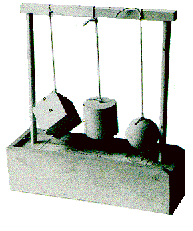
influence of Friedrich Froebel, 1782-1852
- German educator
- the originator of the kindergarten
- worked and studied with the noted Swiss educational reformer
Johann Pestalozzi
- 1816, founded athe Universal German Educational Institute for children
aged 3 to 7
- established in 1837 the first Kindergarten, meaning "children's
garden"
- begins training of kindergarten teachers in 1849
- stressed the natural growth of children
through play
- kindergartens to be established throughout western
Europe, and the US in the 1850's and in Germany and Japan after 1860.
Froebel's Kindergarten
Froebel's kindergarten was a school for the psychological training of
little children by means of play and occupations. The kindergarten method
as defined by Froebel is based upon a series
of geometrical gifts and a system of categories. In the
kindergarten, the child plays with one of the gifts at a time to discover
its properties and possibilites for design. The gifts were
presented to the child in sequence and the child was allowed to
play with them freely. Whenever the child ran
out of ideas for play, the mother or teacher can invoke one or more of the
categories to suggest another way to play. The child is thus encouraged
to think about certain kinds of designs that can be made with the gifts.
Froebel's Gifts

- colored balls - red, orange, yellow, green, blue, purple
- solid wood sphere, cylinder, and cube with dowels to make them tops
and connect them and a
gibbet for swinging them
- wooden cube divided into 8 smaller cubes
- wooden cube divided into 8 oblong blocks
- wooden cube divided into 21 smaller cubes, 6 half-cubes and 12
quarter-cubes, an elaboration of gift 3
- wooden cube divided into 18 oblong blocks, 6 pillars, and 12 squares,
an elaboration of gift 4
- parquetry - flat wood shapes to be arranged on a grid
Other gifts consisted of slats, sticks, rings, strings and points,
colored tablets, colored papers to cut and fold, clay and sand, pencils
and paints.
The wooden blocks, gifts two to six are available from The Froebel Gallery
For details of makers of the original gifts and occupations around the world, send email to froebelweb@yahoo.com
Froebel's Categories
- Forms of Knowledge - mathematical and logical ideas such as number,
proportion, equivalence and order. These ideas serve to define natural
divisions of a gift and to suggest ways of rearranging or transforming
these parts.
- Forms of Life - represent things that can be seen in the outside world
.. buildings, house, table, sofa, tree, etc.
- Forms of Beauty - blocks arranged on a grid without stacking to have
some kind of symmetry, to form patterns viewed as ornament
Sources:
- "Kindergarten Grammars: Designing with Froebel's Building Gifts" by
G. Stiny, Enviroment and Planning B, 1980, vol. 7, pp. 409-462.
- Inventing Kindergarten by Norman Brosterman, Harry N. Abrams,
Inc., New York, 1997.
- "Froebel, Friedrich,"Microsoft Encarta 98 Encyclopedia, 1993-1997,
Microsoft Corporation.
Copyright © 1998-2000 Froebel Web All Rights Reserved. froebelweb@yahoo.com
https://froebelweb.tripod.com/web2004.html

